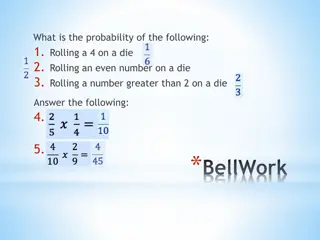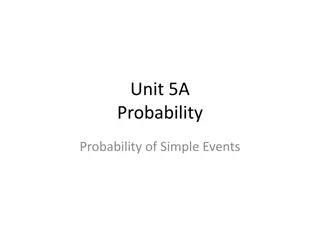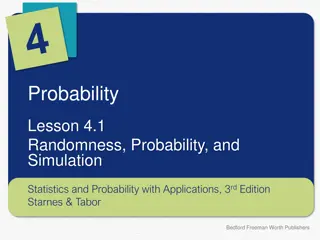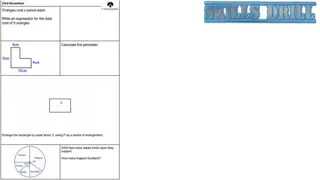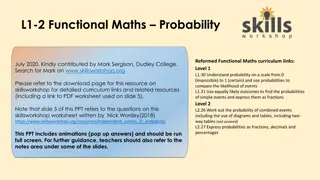Understanding Independence in Probability: A Comprehensive Overview
Explore the concepts of independence and conditional independence in probability, with examples like coin tosses, dice rolls, and real-world scenarios. Learn how knowing the value of one variable affects the probability distribution of another, and how to calculate probabilities under independence assumptions.
Download Presentation

Please find below an Image/Link to download the presentation.
The content on the website is provided AS IS for your information and personal use only. It may not be sold, licensed, or shared on other websites without obtaining consent from the author. Download presentation by click this link. If you encounter any issues during the download, it is possible that the publisher has removed the file from their server.
E N D
Presentation Transcript
LANGUAGE MODELING David Kauchak CS159 Fall 2020 some slides adapted from Jason Eisner
Admin How did assignment 1 finish up? Assignment 2 out soon (two part assignment) Class participation Videos!
Independence Two variables are independent if they do not affect each other For two independent variables, knowing the value of one does not change the probability distribution of the other variable the result of the toss of a coin is independent of a roll of a dice price of tea in England is independent of the whether or not you get an A in NLP
Independent or Dependent? You catching a cold and a butterfly flapping its wings in Africa Miles per gallon and driving habits Height and longevity of life
Independent variables How does independence affect our probability equations/properties? A^B If A and B are independent, written P(A|B) = P(A) P(B|A) = P(B) What does that mean about P(A,B)?
Independent variables How does independence affect our probability equations/properties? A^B If A and B are independent, written P(A|B) = P(A) P(B|A) = P(B) P(A,B) = P(A|B) P(B) = P(A) P(B) P(A,B) = P(B|A) P(A) = P(A) P(B)
Conditional Independence Dependent events can become independent given certain other events Examples, height and length of life correlation studies size of your lawn and length of life http://xkcd.com/552/
Conditional Independence Dependent events can become independent given certain other events Examples, height and length of life correlation studies size of your lawn and length of life A^B|C If A, B are conditionally independent given C P(A,B|C) = P(A|C) P(B|C) P(A|B,C) = P(A|C) P(B|A,C) = P(B|C) but P(A,B) P(A)P(B)
Assume independence Sometimes we will assume two variables are independent (or conditionally independent) even though they re not Why? Creates a simpler model p(X,Y) many more variables than just P(X) and P(Y) May not be able to estimate the more complicated model
Language modeling What does natural language look like? More specifically in NLP, probabilistic model p( sentence ) p( Ilike to eat pizza ) p( pizzalike I eat ) Often is posed as: p( word | previous words ) p( pizza | I like to eat ) p( garbage | I like to eat ) p( run | I like to eat )
Language modeling How might these models be useful? Language generation tasks machine translation summarization simplification speech recognition Text correction spelling correction grammar correction
Ideas? p( Ilike to eat pizza ) p( pizzalike I eat ) p( pizza | I like to eat ) p( garbage | I like to eat ) p( run | I like to eat )
Language modeling I think today is a good day to be me Language modeling is about dealing with data sparsity!
Probabilistic Language modeling A probabilistic explanation of how the sentence was generated Key idea: break this generation process into smaller steps estimate the probabilities of these smaller steps the overall probability is the combined product of the steps
Language modeling Many approaches: n-gram language modeling Start at the beginning of the sentence Generate one word at a time based on the previous words syntax-based language modeling Construct the syntactic tree from the top down e.g. context free grammar eventually at the leaves, generate the words Pros/cons?
n-gram language modeling I think today is a good day to be me
Our friend the chain rule Step 1: decompose the probability P(I think today is a good day to be me) = P(I | <start> ) x P(think | I) x P(today| I think) x P(is| I think today) x P(a| I think today is) x P(good| I think today is a) x How can we simplify these?
The n-gram approximation Assume each word depends only on the previous n-1 words (e.g. trigram: three words total) P(is| I think today) P(is|think today) P(a| I think today is) P(a| today is) P(good| I think today is a) P(good| is a)
Estimating probabilities P(is|think today) How do we find probabilities? Get real text, and start counting (MLE)! P(is|think today) = count(think today is) count(think today)
Estimating from a corpus Corpus of sentences (e.g. gigaword corpus) n-gram language model ?
Estimating from a corpus I am a happy Pomona College student . count all of the trigrams <start> <start> I <start> I am I am a am a happy a happy Pomona happy Pomona College Pomona College student College student . student . <end> . <end> <end> why do we need <start> and <end>?
Estimating from a corpus I am a happy Pomona College student . count all of the trigrams <start> <start> I <start> I am I am a am a happy a happy Pomona happy Pomona College Pomona College student College student . student . <end> . <end> <end> Do we need to count anything else?
Estimating from a corpus I am a happy Pomona College student . count all of the bigrams <start> <start> <start> I I am am a a happy happy Pomona Pomona College College student student . . <end> p(c|a b) = count(a b c) count(a b)
Estimating from a corpus 1. Go through all sentences and count trigrams and bigrams usually you store these in some kind of data structure 2. Now, go through all of the trigrams and use the count and the bigram count to calculate MLE probabilities do we need to worry about divide by zero?
Applying a model Given a new sentence, we can apply the model p( Pomona College students are the best . ) = ? p(Pomona | <start> <start> ) * p( College| <start> Pomona ) * p( students | Pomona College ) * p( <end>| . <end>) *
Generating examples We can also use a trained model to generate a random sentence Ideas? We have a distribution over all possible starting words p( A | <start> <start> ) p( Apples | <start> <start> ) <start> <start> p( I | <start> <start> ) p( The| <start> <start> ) Draw one from this distribution p( Zebras| <start> <start> )
Generating examples <start> <start> Zebras repeat! p( are | <start> Zebras) p( eat | <start> Zebras ) p( think | <start> Zebras ) p( and| <start> Zebras ) p( mostly| <start> Zebras )
Generation examples Unigram are were that res mammal naturally built describes jazz territory heteromyids film tenor prime live founding must on was feet negro legal gate in on beside . provincial san ; stephenson simply spaces stretched performance double-entry grove replacing station across to burma . repairing res capital about double reached omnibus el time believed what hotels parameter jurisprudence words syndrome to res profanity is administrators res offices hilarius institutionalized remains writer royalty dennis , res tyson , and objective , instructions seem timekeeper has res valley res " magnitudes for love on res from allakaket , , ana central enlightened . to , res is belongs fame they the corrected , . on in pressure %NUMBER% her flavored res derogatory is won metcard indirectly of crop duty learn northbound res res dancing similarity res named res berkeley . . off-scale overtime . each mansfield stripes d nu traffic ossetic and at alpha popularity town
Generation examples Bigrams the wikipedia county , mexico . maurice ravel . it is require that is sparta , where functions . most widely admired . halogens chamiali cast jason against test site .
Generation examples Trigrams is widespread in north africa in june %NUMBER% %NUMBER% units were built by with . jewish video spiritual are considered ircd , this season was an extratropical cyclone . the british railways ' s strong and a spot .
Evaluation We can train a language model on some data How can we tell how well we re doing? for example bigrams vs. trigrams 100K sentence corpus vs. 100M
Evaluation A very good option: extrinsic evaluation If you re going to be using it for machine translation build a system with each language model compare the two based on their approach for machine translation Sometimes we don t know the application Can be time consuming Granularity of results
Evaluation Common NLP/machine learning/AI approach Training sentences All sentences Testing sentences
Evaluation Test sentences n-gram language model Ideas?
Evaluation A good model should do a good job of predicting actual sentences Test sentences probability model 1 compare probability model 2
Evaluation Pros: Fine for comparing two models Cons: Doesn t give us a sense of how well any model is doing Test sentences probability model 1 compare probability model 2
The problem Which of these sentences will have a higher probability based on a language model? I like to eat banana peels . I like to eat banana peels with peanut butter.
The problem Which of these sentences will have a higher probability based on a language model? I like to eat banana peels . I like to eat banana peels with peanut butter. Since probabilities are multiplicative (and between 0 and 1), they get smaller for longer sentences.
The solution: perplexity ? ???? ?1..? = ?(??|?1..? 1) ?=1 geometric mean average the probabilities 1 ? ?? ?1..? = ? ?=1 ?(??|?1..? 1)
Calculating perplexity in practice 1/? 1 1 ? =log log ? ?=1 ?(??|?1..? 1) ? ?=1 ?(??|?1..? 1) 1 log ? ?=1 ?(??|?1..? 1) ? = ? = log ?=1 ?(??|?1..? 1) ? ? = ?=1 log ?(??|?1..? 1) ? What is this?
Calculating perplexity in practice 1/? 1 1 ? =log log ? ?=1 ?(??|?1..? 1) ? ?=1 ?(??|?1..? 1) 1 log ? ?=1 ?(??|?1..? 1) ? = ? = log ?=1 ?(??|?1..? 1) ? ? = ?=1 log ?(??|?1..? 1) ? Average logprob per word!
Calculating perplexity 1 ? ?? ?1..? = ? ?=1 ?(??|?1..? 1) ? ?=1 log10?(??|?1..? 1) ? = 10 - This is often how it s calculated (and how we ll calculate it) - Avoid underflow from multiplying too many small probabilities together
Another view of perplexity Weighted average branching factor number of possible next words that can follow a word or phrase measure of the complexity/uncertainty of text (as viewed from the language models perspective)
Smoothing What if our test set contains the following sentence, but one of the trigrams never occurred in our training data? P(I think today is a good day to be me) = P(I | <start> <start>) x P(think | <start> I) x If any of these has never been seen before, prob = 0! P(today| I think) x P(is| think today) x P(a| today is) x P(good| is a) x
A better approach p(z | x y) = ? Suppose our training data includes x y a .. x y d x y d but never: xyz We would conclude p(a | x y) = 1/3? p(d | x y) = 2/3? p(z | x y) = 0/3? Is this ok? Intuitively, how should we fix these?
Smoothing the estimates Basic idea: Discount the positive counts somewhat p(a | x y) = 1/3? reduce p(d | x y) = 2/3? reduce p(z | x y) = 0/3? increase Reallocate that probability to the zeroes Remember, it needs to stay a probability distribution
Other situations p(z | x y) = ? Suppose our training data includes x y a (100 times) x y d (100 times) x y d (100 times) but never: x y z Suppose our training data includes x y a x y d x y d x y (300 times) but never: x y z Is this the same situation as before?
Smoothing the estimates Should we conclude p(a | xy) = 1/3? reduce p(d | xy) = 2/3? reduce p(z | xy) = 0/3? increase Readjusting the estimate is particularly important if: the denominator is small 1/3 probably too high, 100/300 probably about right numerator is small 1/300 is probably too high, 100/300 probably about right p(c|a b) = count(a b c) count(a b)
Add-one (Laplacian) smoothing xya xyb xyc xyd xye xyz 1 0 0 2 0 1/3 0/3 0/3 2/3 0/3 2 1 1 3 1 2/29 1/29 1/29 3/29 1/29 0 3 0/3 3/3 1 1/29 29/29 Total xy 29





